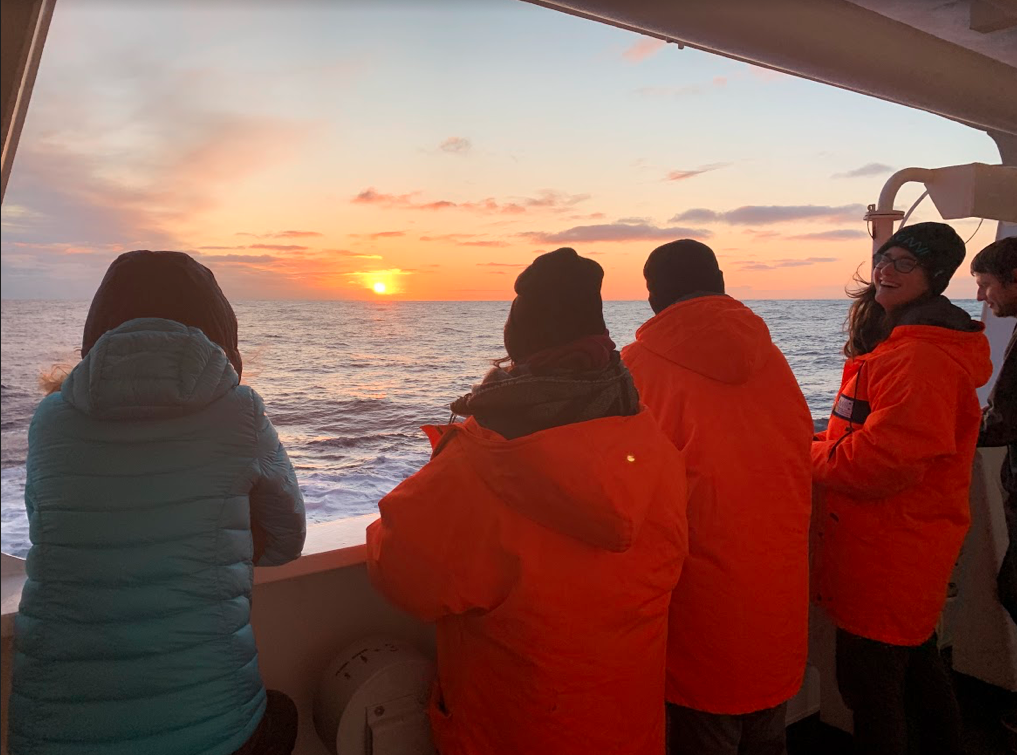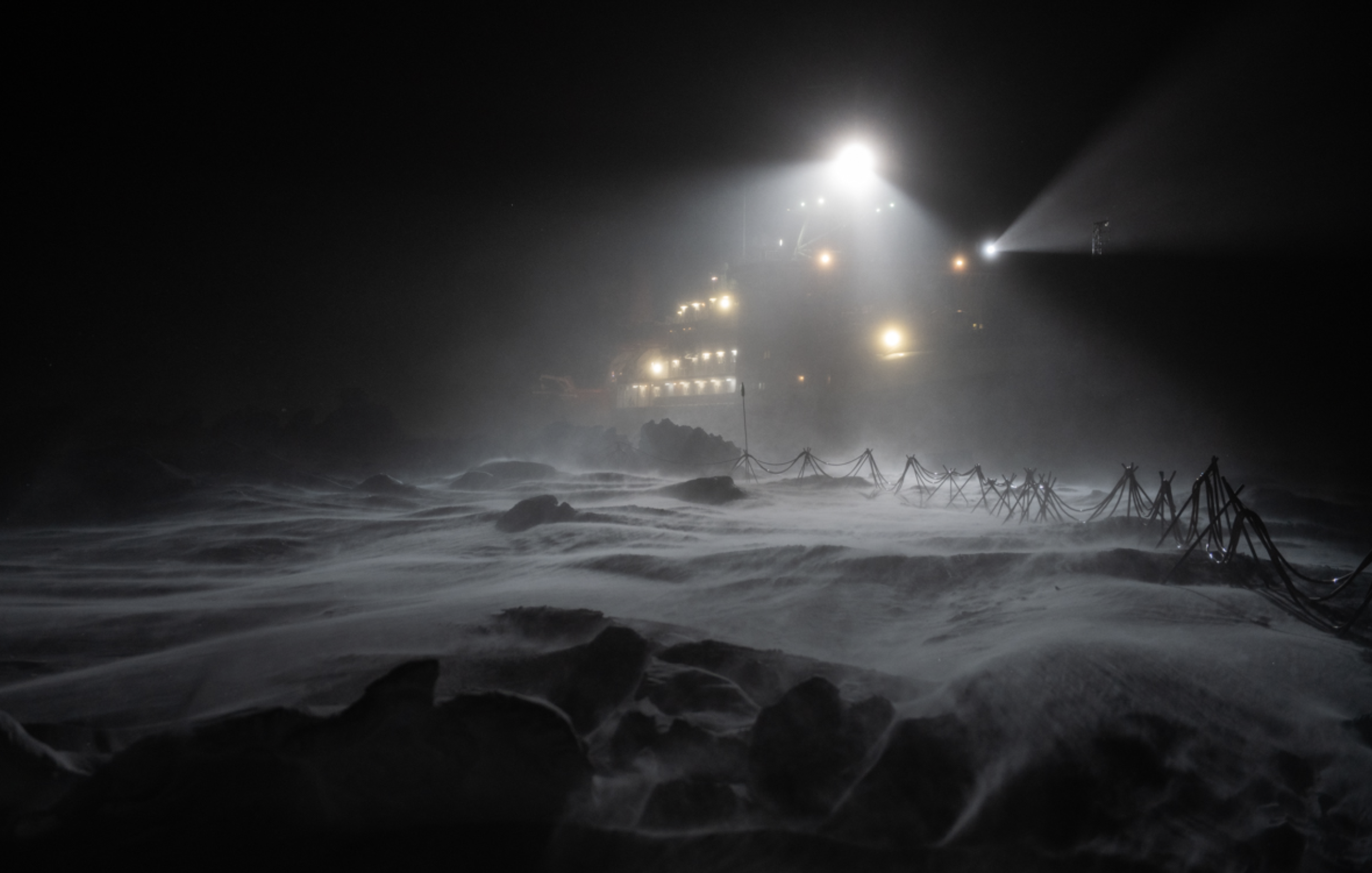An Arctic in Darkness
Beautiful clear skies and cold…. Below -30C for the first time at MOSAiC. Silence. This is really it: the Arctic winter. Full darkness with stars. And what a beautiful day. -Dr. Matt Shupe, research scientist and co-coordinator of MOSAiC. Dr. Shupe is currently on the Polarstern.
Could you spend months in a place where temperatures get lower than -30°C (-23.8°F) and the sun never rises in the winter? MOSAiC scientists and crew on the Polarstern are currently doing just that, but for how much longer?
The Northern Hemisphere winter solstice is right around the corner. This week, we dive into what the solstice is and what it means for MOSAiC. Photo: The Polarstern's spotlights are a bright spot in the otherwise dark Arctic. Photo credit: AWI
Read Dr. Matt Shupe's Postcards from a Frozen Icebreaker
 Quick Bite: What is the Winter Solstice?
Quick Bite: What is the Winter Solstice?
The 2019 Northern Hemisphere winter solstice takes place on December 21st. So what exactly is the winter solstice?
Watch this video from NASA of the earth as it orbits around the sun over the course of a year (one seasonal cycle). You won't actually see the sun, as the video has you positioned as if you were orbiting with the earth from a fixed vantage point. The Northern Hemisphere winter solstice happens at about 3 seconds into the video. Using this hint, can you define what the winter solstice is? If you'd like to watch the earth orbit the sun from a different reference point, check out this seasons interactive. Extension: Does everyone in the world experience the solstice the same?
![]()
![]()
![]()
 What does the winter solstice mean for MOSAiC?
What does the winter solstice mean for MOSAiC?
Note: This activity was first featured in the November 11th edition of MOSAiC Monday.
How long will the Polarstern be in polar night? When will those aboard the icebreaker next see the sun rise? In small groups, have students predict what day they think the sun will next rise for those aboard the Polarstern. Write all predictions on the board. Then, have students use the Day Length Calculator to figure out what day the sun will next rise based on an estimated location of the icebreaker. Photo credit: Anne Gold

How to use the Day Length Calculator
1. Enter in a latitude and longitude location for the Polarstern in the 'Location' box. This will be the predicted approximate location for the Polarstern for whatever date the students chose for when the sun will rise next--they can use the map in this article of the Polarstern's projected drift path to estimate a location. To keep it simple, you can ignore the time zone (this means the predicted date of next sunrise could be off by as much as one day, but it's close enough).
2. Enter in the predicted day of next sunrise in the 'Date' box. Double check the year is correct, and choose whatever time you like.
3. The calculator will automatically do its thing. The 'Apparent Sunrise' will either display the date of the next sunrise at the location you chose if you did not choose a date far enough in advance, or it will show the time of sunrise if you did. Play around with the calculator until you figure out the date of the next sunrise at the Polarstern. How does it compare to your prediction?
Day Length Calculator
![]()
![]()
 #askmosaic: Polarstern Personnel
#askmosaic: Polarstern Personnel
Submitted question: How many people are on the ship at once, and why do you need so many people?

“On each leg there are around 100 people on the ship. This includes the ship's crew (master, mates, technicians, mechanics, stewards and catering personal, etc.) to run the ship and a lot of scientists (from different subjects) that do measurements and take samples for all the research projects that are taking part in this expedition. Most projects on board aim to get data from the whole year but cannot send one person for each project for the whole time. This means that the people on board have to do a lot of different tasks for other projects including the work for their own project. Additionally there are also some logistics people on board that help with a lot of general work.”
-Dr. Julia Regnery, Sea Ice Physicist and Scientific Coordinator for the MOSAiC Ocean and Sea Ice teams. Dr. Regnery will be returning soon from Leg I of the MOSAiC expedition, then will go back to the Arctic in mid-April of 2020 for Leg IV of the expedition.
Photo: Maren Zahn, baker on the Polarstern, wakes up at 3:45 am every day to bake bread, prepare breakfast, and bake cakes to be served in the afternoon. Photo credit: Esther Horvath
Send us your questions!
 MOSAiC Weekly Tracking
MOSAiC Weekly Tracking
Plot the Polarstern
Each week we will provide you with the latitude and longitude coordinates of the Polarstern so that your students can track its journey across the Arctic in your classroom.
Download the map to plot coordinates
Download a larger map of the Arctic for a bigger picture view of the expedition area
Location of the Polarstern
| Date | Latitude | Longitude |
| September 16, 2019 | 69.68 N | 18.99 E |
| September 23, 2019 | 72.31 N | 26.93 E |
| September 30, 2019 | 85.12 N | 138.05 E |
| October 4, 2019** | 85.08 N | 134.43 E |
| October 7, 2019 | 85.10 N | 133.82 E |
| October 14, 2019 | 84.85 N | 135.03 E |
| October 21, 2019 | 84.97 N | 132.73 E |
| October 28, 2019 | 85.47 N | 127.07 E |
| November 4, 2019 | 85.88 N | 121.70 E |
| November 11, 2019 | 85.82 N | 116.00 E |
| November 18, 2019 | 86.05 N | 122.43 E |
| November 25, 2019 | 85.85 N | 121.35 E |
| December 2, 2019 | 85.97 N | 112.95 E |
| December 9, 2019 | 86.25 N | 121.40 E |
| December 16, 2019 | 86.62 N | 118.12 E |
**Day when MOSAiC reached the ice floe that the Polarstern will become frozen in and drift with for the next year.
Log MOSAiC Data
Download a MOSAiC Data Logbook to keep track of Arctic conditions over the course of the expedition
Arctic Data* - NOTE: Length of day numbers have been updated based on more accurate models!
| Date | Length of day (hrs) | Air temperature (deg C) at location of Polarstern | Arctic Sea Ice Extent (million km2) |
| September 16, 2019 | 13.25 | High: 10 Low: 4.4 | 3.9 |
| September 23, 2019 | 12.35 | High: 6 Low: -1 | 4.1 |
| September 30, 2019 | 9.1 | -4.7 | 4.4 |
| October 4, 2019** | 6.27 | -13.0 | 4.5 |
| October 7, 2019 | 3.05 | -8.2 | 4.6 |
| October 14, 2019 | 0 | -14.7 | 4.8 |
| October 21, 2019 | 0 | -12.8 | 5.4 |
| October 28, 2019 | 0 | -18.3 | 6.8 |
| November 4, 2019 | 0 | -18.9 | 8.0 |
| November 11, 2019 | 0 | -25.5 | 8.7 |
| November 18, 2019 | 0 | -10.7 | 9.3 |
| November 25, 2019 | 0 | -18.4 | 10.0 |
| December 2, 2019 | 0 | -26.6 | 10.4 |
| December 9, 2019 | 0 | -23.1 | 11.2 |
| December 16, 2019 | 0 | -19.2 | 11.8 |
*Note: We expect data to fall within the following ranges: Length of day, 0-24 hours; Temperature, -40 to 14 degrees C; Sea ice extent, 3-15 million km2
**Day when MOSAiC reached the ice floe that the Polarstern will become frozen in and drift with for the next year.
 MOSAiC Ambassadors' Corner
MOSAiC Ambassadors' Corner
Lectures, videos, podcasts and workshops: during the upcoming year, follow the MOSAiC School outreach activities with the MOSAiC Ambassadors' Corner.
This month, discover two amazing videos from our Ambassadors:
- Rosalie McKay's clip "The MOSAiC School in 52 seconds" will give you a sneak peek of these fascinating 6 weeks in the Arctic as a MOSAiC School student.
- Find out about the highlights of the MOSAiC Leg 1a onboard the RV Akademik Fedorov, with a short and inspiring movie from Anika Happe.
Stay tuned for monthly updates!
 MOSAiC Monday and the NGSS
MOSAiC Monday and the NGSS
What do those funny symbols below some engagements mean?
Good news for educators in the U.S. teaching with the Next Generation Science Standards (NGSS) or similar! We will now be tagging MOSAiC Monday engagements with the NGSS Disciplinary Core Idea subject(s), Science and Engineering Practice(s), and Crosscutting Concept(s) that they most closely connect to. Look for these symbols listed below each engagement:
Disciplinary Core Idea Subjects
Science and Engineering Practices (adopted from the San Diego County Office of Education Science Resource Center)
Crosscutting Concepts (adopted from the San Diego County Office of Education Science Resource Center)
Is there something you'd like to see in MOSAiC Monday? Let us know!
Send us your feedback
New to MOSAiC Monday? Check out past editions!
Browse more expedition-related educational resources, videos, and blogs

